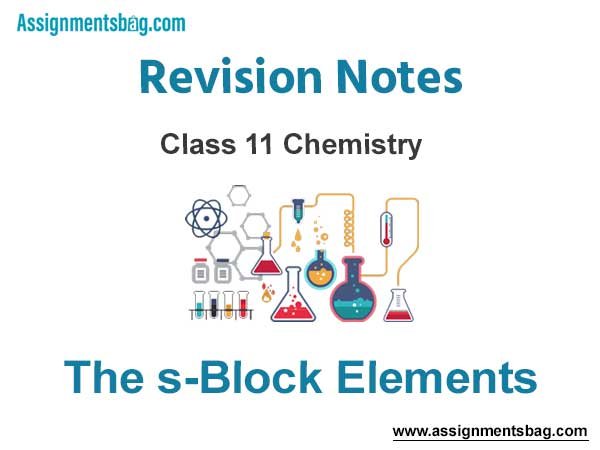Please refer to the The s-Block Elements Revision Notes given below. These revision notes have been designed as per the latest NCERT, CBSE and KVS books issued for the current academic year. Students will be able to understand the entire chapter in your class 11th Chemistry book. We have provided chapter wise Notes for Class 11 Chemistry as per the latest examination pattern.
Revision Notes Chapter 10 The s-Block Elements
Students of Class 11 Chemistry will be able to revise the entire chapter and also learn all important concepts based on the topic wise notes given below. Our best teachers for Grade 11 have prepared these to help you get better marks in upcoming examinations. These revision notes cover all important topics given in this chapter.
Important points
♦ Groups (1 & 2) belong to the s-block of the Periodic Table.
♦ Group 1 consists of : lithium, sodium, potassium, rubidium, caesium and francium and collectively known as the alkali metals.
♦ Group 2 include : beryllium, magnesium,calcium, strontium, barium and radium. Except Beryllium they are known as alkaline
Physical properties
Large atomic radii: The atomic radii of alkali metals are the largest in their respective periods. These increase as we travel down the group.
Large ionic radii: The ionic radii increase as we move down the group due to the addition of a new energy shell with each succeeding element.
Low ionization enthalpy: The ionization enthalpies decrease as we move down the group.The ionization enthalpies of the alkali metals are the lowest due to loosely held s- electron.
Hydration enthalpy: It decreases with the increase in ionic radii.The hydration enthalpy of Li ion is the maximum and the hydration enthalpy of Cs ion is the minimum.
Oxidation state: The alkali metals exhibit oxidation state of +1 in their compounds and are strongly electro positive in character. The electr opositive character increases from Li to Cs.
Metallic character: The metallic character increases down the group.
Melting point and boiling point: The m p and b p of alkali metals are very low and decrease with increase in atomic number.
Nature of bonds formed: These metals form ionic bonds. The ionic character increases as we down the group.
Flame colouration: All the alkali metals impart a charactersistic colour to the flame.
Photoelectric effect: Alkali metals (except Li) exhibits photoelectric effect.
Chemical features of alkali metals:
Reducing character: As the ionization enthalpies of the alkali metals decrease down the group their reducing character or reactivity in the gaseous state increases down the group. i.e., Li < Na < K < Rb < Cs .
Reaction with dihydrogen: Alkali metals react with dry hydrogen at about 673 K to form crystalline hydrides which are ionic in nature and have high melting points.
Heat
2 M + H2 → 2M + H–
Oxides and hydroxides: Alkali metals when burnt in air form different compounds, for example the alkali metals on reaction with limited quantity of oxygen form normal oxides ( M2O) M= Li, Na, K, Rb, Cs
Reaction with halogens: The members of the family combine with halogen to form corresponding halides which are ionic crystalline solids. Reactivity of alkali metls with particular halogen increases from Li to Cs.
Reaction with water: Alkali metals react with water and other compounds containing acidic hydrogen atoms such as hydrogen halides, acetylene etc. to liberate hydrogen gas.
Solubility in liquid ammonia: All alkali metals dissolve in liquid ammonia giving deep blue solutions which are conducting in nature.
Reaction with sulphur and phosphorus: Alkali metals react with sulphur and phosphorus on heating to form sulphides and phosphides respectively.
Diagonal relationship between Li and Al
Li resembles Mg mainly due to similarity in sizes of their atoms and ions. The main points of similarity are:
♦ Both are quite hard.
♦ Both LiOH and Mg(OH)2 are weak bases.
♦ Carbonates of both on heating decompose to produce oxides and carbondioxide.
♦ Both react with nitrogen to give ionic nitrides.
♦ Nitrates of both decompose on heating to give oxides.
♦ Both Li and Mg do not form solid bicarbonates.
♦ Because of covalent character LiCl and MgCl2 are soluble in ethanol.
♦ The hydroxides, bicarbonates and fluorides of both Li and Mg are sparingly soluble in water.
Biological importance of Na and K
♦ Sodium ions participate in the transmission of nerve signals.
♦ Sodium ions also regulate flow of water across the cell membranes and in transport of sugars and amino acids into the cells.
♦ Potassium ions are the most abundant cations within cell fluids, where they activate many enzymes, participate in oxidation of glucose to produce ATP.
♦ Potassium ions in combination with sodium ions are responsible for transmission of nerve signals.
♦ The functional features of nerve cells depend upon the sodium potassium ion gradient that is established in the cell.
Group 2 elements: Alkaline earth metals
Atomic radii : The atomic radii of alkaline earth metals are fairly large though smaller than the corresponding alkali metals and they increase down the group. This is because on moving down the group, atomic radii increase primarily due to the addition of an extra shell of electrons in each succeeding element.
Ionic radii: the atoms of these elements form divalent ions which show the same trend of increase in their size down the group.
Ionization enthalpy: The alkaline earth metals have fairly low Ionizations enthalpies though greater than those of the corresponding elements of group 1 and this value decreases down the group.
Hydration enthalpy: the Hydration enthalpies of alkaline earth metal ion decrease as the size of the metal ion increases down the Group Be2+ >Mg2+ >Ca2+ >Sr2+ >Ba2+
Oxidation State: All the members of the family exhibit +2 oxidation state in their compounded and the form divalent cations (M2+)
Electro negativity : The electro negativity values of alkaline earth metals are quite close to those of alkali metals, though slightly more.
Metallic Character : Alkaline earth metals have stronger metallic bonds as compared to the alkali metals present in the same period.
Melting and boiling point : The melting and Boiling points of these metals are higher than those of alkali metals present in the same period.
Colouration to the flame : With the exceptio9n of beryllium and magnesium, the rest of the elements impart characters in colour to the same flame. For example,
Be Mg Ca Sr Ba Ra
– – Brick Red Crimson Grassy Green Crimson
Complex formation: Generally the members do not form complexes. However, smaller ions ( Be & Mg Ions) form complexes with the electron donor species
Formation of organo-metallic compounds: Both beryllium and magnesium form a number of organo-metallic compounds containing M-C bond with certain organic compounds. For example, magnesium reacts with alkyl halide in the presence of dry ether to give Grignard reagent.
Reducing character: Alkaline earth metals are weak reducing agent than the corresponding alkali metals which have lower ionization enthalpies and comparatively bigger atomic sizes. m) Reaction with oxygen: With the exception of Ba and Ra which form peroxides ( MO2) rest of the metals form normal oxides (MO) on heating with excess of oxygen.
Reaction with halogens: The members of the family combine directly with halogen at appropriate temperature to form corresponding halides.
Reaction with water: The members of this group are less reactive towards water as compared to the corresponding alkali metals because these are less electropositive in nature.
Reaction with hydrogen: The members except Be combine with hydrogen directly upon heating to form metal hydrides. Uses of some important compounds:-
a) Caustic soda:
It is used: in soap, paper, textile, petroleum industry
b) Sodium carbonate:
It is used:
♦ in glass and soap industry
♦ in paper making and textile manufacturing
♦ in paint and dye stuffs
♦ in metal refining
♦ in production of sodium compounds such as borax, caustic soda, sodium phosphate etc
c) Quick lime:
It is used:
♦ in the preparation of cement, glass and calcium carbide.
♦ In the purification of sugar
♦ In softening of hard water d. As a flux in the extraction of metal
d) Lime stone:
It is used
♦ as building material
♦ in the manufacture of quick lime
♦ in Solvay process to prepare Na2CO3 as it is a source of CO2
♦ in metallurgy for the extraction of iron
♦ in toothpaste and certain cosmetics
e)Cement: It is an important building material. It is used in concrete and reinforced concrete, in plastering and in the construction of bridges, dams and buildings.
f) Plaster of paris:
It is used
♦ in making moulds for pottery and ceramics etc.
♦ in surgical bandages for setting broken bones of the body
♦ for making statues, models, decorative materials and black board chalk.
Biological importance of Ca and Mg
♦ Magnesium ions are concentrated in animal cells and Calcium ions are concentrated in body fluids, outside the cell.
♦ All enzymes that utilize ATP in phosphate transfer require magnesium ion as cofactor.
♦ In green plants magnesium is present in chlorophyll.
♦ Calcium and magnesium ions are also essential for the transmission of impulses along nerve fibres.
♦ Calcium ions are important in blood clotting and are required to trigger the contraction of muscles.
♦ Calcium ions also regulate the beating of the heart.



